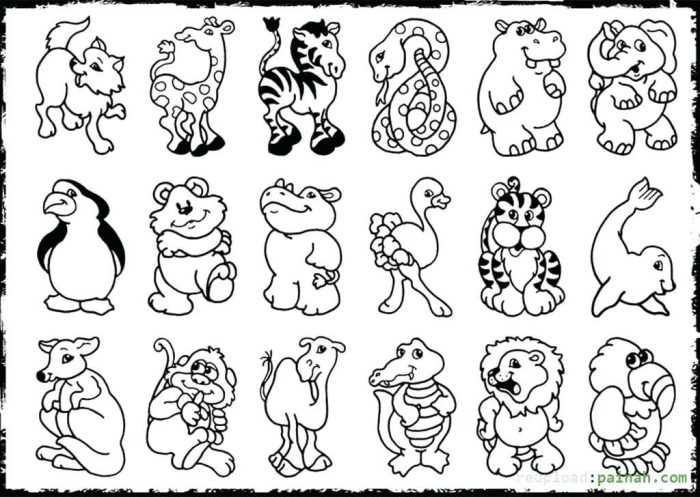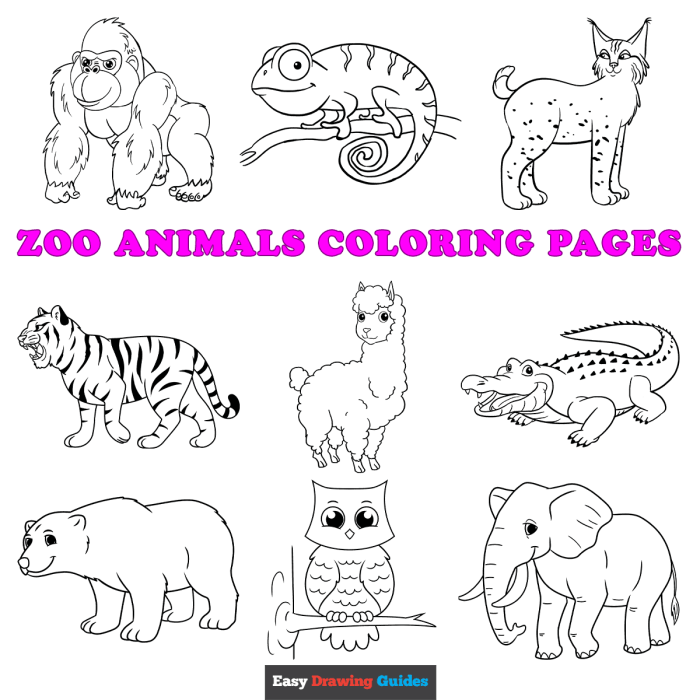Educational Benefits and Developmental Aspects

Animal coloring sheets for children – Coloring, particularly with engaging themes like animals, offers a wealth of cognitive and developmental benefits for children of all ages. It’s a fun and accessible activity that subtly strengthens crucial skills, fostering both creativity and academic progress. The act of coloring itself, combined with the subject matter, creates a powerful learning experience.Animal coloring sheets provide a unique opportunity to blend entertainment with education, making learning about the natural world enjoyable and memorable.
Animal coloring sheets for children are a fun and educational activity, offering a creative outlet while subtly introducing them to the animal kingdom. For a slightly more advanced approach, you might consider introducing them to the intricacies of cell biology with resources like the animal cell coloring code , which can help them visualize the building blocks of life.
Returning to simpler activities, these coloring sheets remain a great way to foster creativity and learning in young children.
The visual engagement and creative process actively contribute to a child’s overall development.
Cognitive Benefits of Coloring
Coloring enhances focus and concentration. The repetitive action of staying within the lines helps children develop their attention span and ability to concentrate on a single task. This improved focus is transferable to other areas of learning, such as reading and problem-solving. Furthermore, choosing colors, deciding on shading techniques, and creating their own unique interpretations of the animals fosters creativity and self-expression.
The process encourages imaginative thinking and allows children to explore their own artistic style. Finally, the act of completing a coloring page provides a sense of accomplishment and boosts self-esteem.
Enhancing Animal Learning through Coloring Sheets
Animal coloring sheets can significantly enhance a child’s understanding of the animal kingdom. For example, a coloring page featuring a lion could include labels for its mane, paws, and tail, teaching children the animal’s physical characteristics. Similarly, a coloring page of a polar bear could depict its icy habitat, prompting discussion about its environment and survival strategies. Incorporating these educational elements makes learning fun and engaging, transforming a simple coloring activity into a valuable learning experience.
Children are more likely to retain information when it’s presented in a visually stimulating and interactive way.
Incorporating Educational Elements into Designs
The designs themselves can be enriched with educational elements. Adding labels to body parts, such as “trunk” for an elephant or “wings” for a butterfly, provides immediate vocabulary enrichment. Including factual information about habitats, diets, or behaviors in small text boxes alongside the illustration further enhances learning. For example, a coloring sheet featuring a giraffe could include a fact about its long neck allowing it to reach high leaves.
This approach seamlessly integrates learning into the creative process, making the activity both enjoyable and informative. The visual cues paired with the factual information reinforce learning and improve retention.
Improving Fine Motor Skills and Hand-Eye Coordination
The act of coloring significantly improves fine motor skills and hand-eye coordination. Children develop dexterity and control over their hands and fingers as they carefully color within the lines. This strengthens small muscle groups, preparing them for writing and other tasks requiring precision. The coordination between the eyes and hands improves as children learn to guide their coloring tools accurately.
The repetitive nature of coloring strengthens these skills gradually and naturally.
Developmental Benefits by Age Group
The benefits of animal coloring sheets are varied and evolve as children grow. Here’s a breakdown by age group:
- Preschool (Ages 3-5): Focus on large, simple designs with bold Artikels. This helps develop basic hand-eye coordination, color recognition, and self-expression. Simple labels for body parts can be introduced.
- Early Elementary (Ages 6-8): Introduce more complex designs with finer details. Incorporate simple facts about animals and their habitats. Encourage children to label body parts and create their own stories about the animals.
- Late Elementary (Ages 9-12): Offer more intricate designs with opportunities for shading and creative interpretation. Include more detailed facts and encourage research into specific animals. Challenge children to create their own informative captions or short stories about the animals they color.
Marketing and Distribution of Animal Coloring Sheets

Successfully marketing and distributing animal coloring sheets requires a multifaceted approach, considering both online and offline strategies to reach the target audience of parents and educators. Understanding the various platforms and marketing techniques is crucial for maximizing sales and brand visibility.Effective marketing strategies are essential for reaching parents and educators, the primary consumers of children’s coloring books. This involves understanding their needs and preferences, and tailoring marketing messages accordingly.
Distribution channels, meanwhile, impact accessibility and ultimately, sales volume.
Online Sales Platforms
Several online platforms offer avenues for selling digital and physical animal coloring sheets. Print-on-demand services, such as Printful or Printify, allow creators to list their designs without managing inventory. Etsy and Amazon Handmade provide established marketplaces with built-in customer bases. Creating a dedicated website offers greater control over branding and customer experience but requires more upfront investment in website development and marketing.
Each platform has unique advantages and disadvantages concerning fees, marketing tools, and customer reach. For example, Printful handles printing and shipping, reducing the seller’s workload, but takes a larger cut of the profit compared to selling directly from a website.
Marketing Strategies for Parents and Educators
Reaching parents and educators necessitates different marketing approaches. For parents, social media marketing on platforms like Instagram and Facebook, showcasing visually appealing coloring pages and emphasizing the educational benefits, proves effective. Targeted advertising campaigns can further refine reach. Educators, on the other hand, may be better reached through educational blogs, teacher forums, and online marketplaces specializing in educational resources.
Offering bulk discounts or educator-specific bundles can also incentivize purchases.
Distribution Channel Comparison
Print-on-demand services offer low-risk entry, eliminating inventory management concerns. However, profit margins are typically lower due to the service fees. Selling through established marketplaces like Etsy or Amazon leverages existing customer bases but involves competition and platform fees. A dedicated website offers maximum control and higher profit margins but requires significant upfront investment in website creation and marketing.
The optimal distribution strategy depends on the creator’s resources, technical skills, and marketing capabilities.
Creating and Selling a Collection of Animal Coloring Sheets
The process of creating and selling a collection of animal coloring sheets involves several key steps. This process requires careful planning and execution to ensure success. Effective organization is key to a smooth process.
Step 1: Design and Create Coloring Sheets:Develop a range of animal-themed coloring pages with varied complexity levels to cater to different age groups.Step 2: Choose a Sales Platform:Select an online platform (e.g., Etsy, Printful, dedicated website) based on your resources and goals.Step 3: Prepare Product Listings:Create high-quality images of the coloring sheets and write compelling product descriptions highlighting the educational benefits and target age group.Step 4: Set Pricing and Shipping:Determine competitive pricing, factoring in production costs and platform fees. Establish clear shipping policies.Step 5: Market Your Products:Utilize social media marketing, targeted advertising, and collaborations with relevant influencers or educators to promote your coloring sheets.Step 6: Manage Orders and Customer Service:Process orders promptly and efficiently, providing excellent customer service to build positive reviews and brand loyalty.
Illustrative Examples and Descriptions

These examples showcase the diverse possibilities for animal coloring sheets, highlighting various artistic styles, animal poses, and environmental settings to inspire creativity and engagement in young learners. The descriptions aim to provide a clear picture of the visual elements, color palettes, and overall aesthetic appeal of each design.
Lion Coloring Sheet
This coloring sheet features a majestic lion in a profile pose, its head turned slightly to the viewer, showcasing its impressive mane. The lion is depicted in a savanna setting, with tall grasses and acacia trees subtly rendered in the background, suggesting a natural habitat. The artistic style is realistic, with attention to detail in the lion’s musculature and fur texture.
The line work is clean and precise, allowing for easy coloring within the defined areas. The suggested color palette includes various shades of tawny brown for the lion’s coat, a lighter cream for its underbelly, and a deep amber for its mane. Black is used sparingly to accentuate the eyes and nose, while hints of green and brown are used to suggest the surrounding vegetation.
Playful Monkeys in the Jungle
This coloring sheet bursts with energy, depicting a group of playful monkeys swinging through a vibrant jungle setting. The monkeys are rendered in a slightly cartoonish style, with exaggerated features and expressive poses that capture their playful nature. They are shown interacting with each other, some swinging from vines, others playfully chasing each other amongst lush foliage. The jungle backdrop is richly detailed, featuring a variety of tropical plants, flowers, and leafy vines, creating a sense of depth and complexity.
The color palette is bright and cheerful, featuring vibrant greens, yellows, oranges, and browns, complemented by the playful shades used to color the monkeys themselves. The line work is less precise than the lion sheet, allowing for a more free-flowing and whimsical aesthetic.
Underwater Scene with Sea Creatures
This coloring sheet transports the child to the depths of the ocean, featuring a diverse array of sea creatures in a vibrant underwater scene. The composition is carefully arranged, with coral reefs forming a central focal point, surrounded by various fish, a playful dolphin, and a majestic sea turtle. The artistic style is realistic, capturing the unique textures and colors of each creature.
Details such as the scales on the fish, the coral’s intricate structure, and the turtle’s shell are carefully rendered, inviting children to explore the nuances of the underwater world. The color palette is rich and varied, incorporating blues, greens, yellows, and oranges, reflecting the diverse colors found in coral reefs. The line work is delicate and precise, creating a sense of depth and movement in the underwater scene.
Arctic Habitat Coloring Sheet
This coloring sheet depicts a polar bear amidst a snowy arctic landscape. The polar bear is shown standing majestically on an ice floe, its fur rendered with subtle shading to suggest texture and volume. The background includes a vast expanse of ice and snow, with a subtle hint of a distant mountain range. The color palette is limited to whites, blues, and grays, reflecting the stark beauty of the arctic environment.
The line work is simple yet effective, emphasizing the bear’s form and the vastness of the icy landscape.
Rainforest Habitat Coloring Sheet
This vibrant coloring sheet showcases a lush rainforest environment, teeming with life. A brightly colored parrot is perched prominently on a branch, surrounded by various tropical plants and flowers. The color palette is rich and diverse, reflecting the vibrant colors of the rainforest. The line work is detailed, capturing the texture of the parrot’s feathers and the intricate details of the rainforest flora.
Desert Habitat Coloring Sheet, Animal coloring sheets for children
This coloring sheet presents a camel traversing a sandy desert landscape. The camel is shown with its characteristic humps, and the background includes sand dunes and sparse desert vegetation. The color palette is earthy, featuring shades of brown, beige, and yellow. The line work is simple and clean, emphasizing the essential features of the camel and the desert environment.
Query Resolution: Animal Coloring Sheets For Children
What age range are animal coloring sheets suitable for?
Animal coloring sheets are adaptable to various age groups. Simpler designs are ideal for preschoolers, while more complex ones challenge older children.
Where can I find free animal coloring sheets?
Many websites and online resources offer free printable animal coloring sheets. A simple online search should yield numerous results.
Are there coloring sheets with specific animal facts?
Yes, many educational coloring sheets incorporate facts about animals, their habitats, and behaviors.
What types of paper are best for coloring sheets?
Heavier weight paper, such as cardstock, is recommended to prevent bleed-through, especially with markers or crayons.


